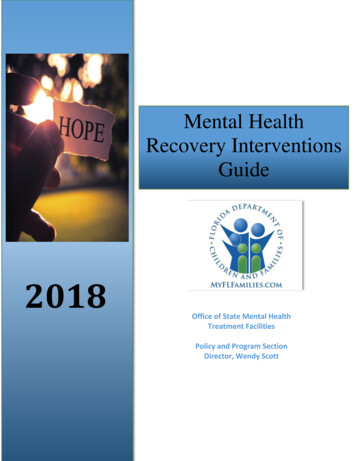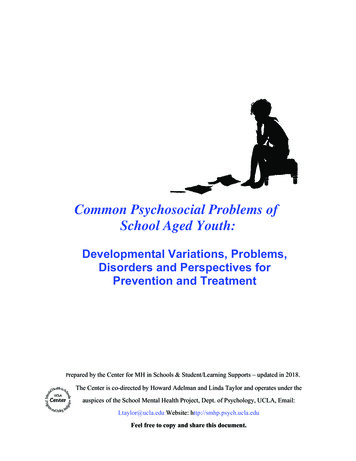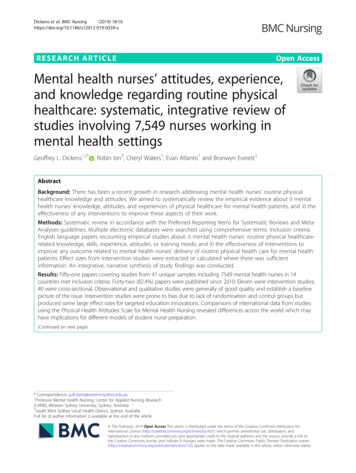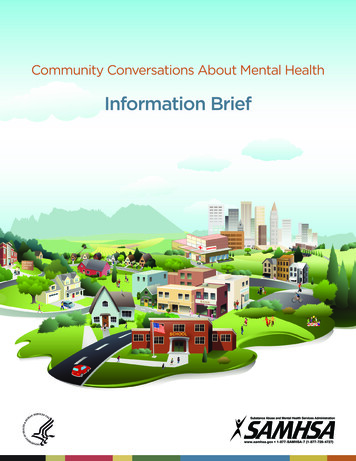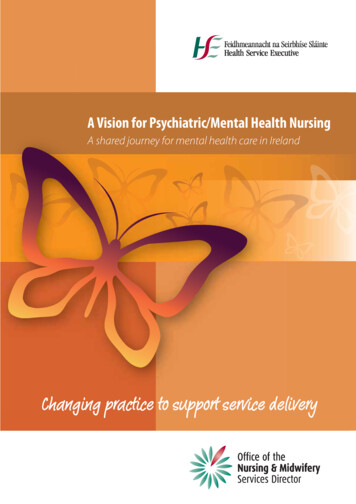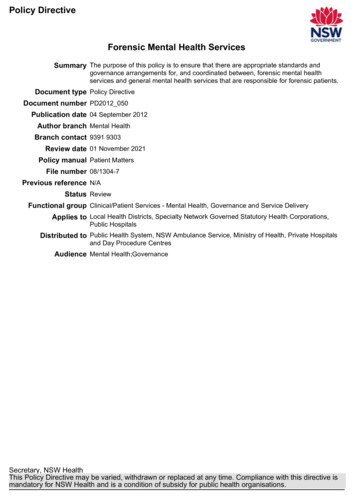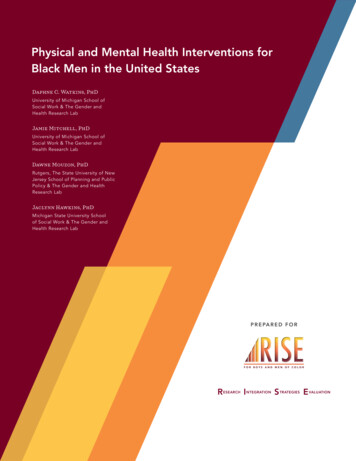
Transcription
Physical and Mental Health Interventions for Black Men in the United StatesPhysical and Mental Health Interventions forBlack Men in the United StatesDaphne C. Watkins, PhDUniversity of Michigan School ofSocial Work & The Gender andHealth Research LabJamie Mitchell, PhDUniversity of Michigan School ofSocial Work & The Gender andHealth Research LabDawne Mouzon, PhDRutgers, The State University of NewJersey School of Planning and PublicPolicy & The Gender and HealthResearch LabJaclynn Hawkins, PhDMichigan State University Schoolof Social Work & The Gender andHealth Research LabP R E PA R E D F O RR ESEARCH I NTEGRATION S TRATEGIES E VALUATION
R ESEARCH I NTEGRATION S TRATEGIES E VALUATIONRISE for Boys and Men of Color is a field advancement effort that aims tobetter understand and strategically improve the lives, experiences, andoutcomes of boys and men of color in the United States.Support for this study was provided by a grant funded by The AtlanticPhilanthropies, The Annie E. Casey Foundation, Marguerite Casey Foundation,WK Kellogg Foundation, and members of the Executives’ Alliance to ExpandOpportunities for Boys and Men of Color. The conclusions and opinions expressedin this study are of the author(s) alone and do not necessarily represent the views ofRISE for Boys and Men of Color or its funders.
Physical and Mental Health Interventions for Black Men in the United StatesTable of ContentsINTRODUCTION . 4How to Read this Field Scan Report . 5BACKGROUND . 6METHODS . 8Analytic Framework . 8Search Procedures . 8Review and Analyses Procedures . 9FIELD SCAN FINDINGS . 10Empirical Literature . 10Grey Literature . 19DISCUSSION . 31Physical Health Field Scan . 31Mental Health Field Scan . 32RECOMMENDATIONS . 34REFERENCES . 39ABOUT THE AUTHORS . 43RISE FOR BOYS AND MEN OF COLOR3
Physical and Mental Health Interventions for Black Men in the United StatesIntroductionThis report, submitted to RISE for Boys and Men of Color (BMOC), is a comprehensive report of the findings from a field scan performed by the University of Michigan (U-M) Gender and Health Research (GendHR) Lab on physical and mental health interventionsfor black men1 in the United States.This field scan is a natural extension of the GendHR Lab’s work on black men’s social and cultural experiences, and how theseexperiences contribute to their health trajectories and transitions. For the current RISE field scan, members of the GendHR Labconducted a thorough and systematic review of the empirical and grey literatures to identify successful strategies used by organizations, agencies, and individuals across the United States to develop and maintain physical and mental health interventions forblack men ages 18 and older.Several physical and mental health interventions that target black men exist. Yet, few studies have (a) examined the unique characteristics of these interventions, and (b) examined the way these interventions have improved health outcomes for black men. Thecurrent field scan sought to extend the work of previous studies by applying an intersectional approach to examining patterns insuccessful physical and mental health interventions for black men. There is a need for this field scan because it increases knowledge about the influences of contextual factors on individual- and community- level intervention work that is currently being donewith black men. Therefore, we are pleased to submit a field scan that provides a comprehensive synopsis of previous and existingphysical and mental health interventions that target black men in the United States.This RISE field scan on physical and mental health interventions for black men in the United States contributes to the knowledgeneeded to develop culturally sensitive and gender-specific health intervention approaches for black men in the future. This fieldscan also provides an important basis for policy decisions regarding physical and mental health services and in designing interventions that will be most effective for subgroups of black men. Through this field scan, we strive to understand the disparity betweenhow black men articulate physical and mental health conditions and researchers and practitioners’ roles in working with them to improve these conditions. Acknowledging the importance of physical and mental health for black men will inform a strengths-basedframework that documents the range of health-specific needs of this subgroup of men of color. A strengths-based framework isnecessary to create evidence-based treatments and strategies to improve their health conditions. Overall, this field scan significantly advances a grossly under-studied area of culturally sensitive and gender--specific health interventions that are designed andimplemented (specifically) with black men in mind.For the purposes of this field scan, black men are defined as men of African descent, who are aged 18 and older. This definition, as well as the literaturereviewed and reported in this field scan, is inclusive of information that has been tailored and targeted for both “black” and “African American” men.1 RISE FOR BOYS AND MEN OF COLOR4
Physical and Mental Health Interventions for Black Men in the United StatesHow To Read This Field Scan ReportTo understand the types of US-based physical and mental health interventions that currently exist for black men, this field scanis divided into two major sections. The first section is focused on physical health interventions for black men, defined as programmatic efforts that include clinical and nonclinical (i.e., community and/or institution-based) health promotion strategies thataddress physical health conditions (e.g., diabetes, cancer, HIV, and heart disease) in black men. To denote sections of this field scanreport that underscore the procedures, results, and discussions that focus solely on physical health interventions, an orange hearticon (see below) will be used.P H YSICAL HEALTHThe second section of this field scan report underscores mental health interventions for black men, defined as programmaticefforts that include clinical and nonclinical (i.e., community and/or institution-based) health promotion strategies that are designedto address, improve, and maintain the mental, emotional, or psychological health conditions (i.e., anxiety, psychological distress,stress, and depression) in black men. To denote sections of this field scan report that underscore the procedures, results, and discussions that focus solely on mental health interventions, a blue brain icon (see below) will be used.ME NTAL H EALTHBoth empirical and grey literatures that provide evidence of physical and mental health interventions for black men in the United States are presented under each health section (physical and mental). The only sections of this field scan report that are notseparated by physical health and mental health interventions are the Methods and Recommendations. We begin with a brief butcomprehensive background on the state of the science (page 6) on black men’s physical and mental health. Next, we describe themethods (page 8) employed for our field scan, including the analytic framework, search criteria, and review and analyses procedures. Then, we present our field scan findings (page 10) beginning with the empirical literature from our scan of physical and mental health interventions, followed by the grey literature from our scan of physical and mental health interventions. The discussion(page 31) of our field scan findings outlines the gaps in the empirical and grey literatures, as well as policy and practice implications.Finally, we end our field scan report with a list of ten recommendations (page 34) and considerations for future physical and mentalhealth interventions for black men.P H Y S I C A L H E A LT HRISE FOR BOYS AND MEN OF COLORM E N TA L H E A LT H5
Physical and Mental Health Interventions for Black Men in the United StatesBackgroundBLACK ME N’S HEALTH: THE S TATE O F THE S CIEN C EBlack Men’s Physical HealthAs a population, black men have the worst health profile and disproportionately suffer premature death and significantly higher incidence of common diseases when compared to men and women of every racial group in the United States. Research consistentlydemonstrates that black men are more likely to experience undiagnosed or poorly managed chronic conditions such as diabetes,heart disease, cancer, HIV, and hypertension. For example, black men are more likely to be diagnosed with Type 2 diabetes (T2D),are 14 times more likely to experience kidney failure due to hypertension, have a 30 percent higher mortality rate due to cardiovascular disease, and a 60 percent higher mortality rate from stroke compared to non-Hispanic white men. Further, black men are31 percent more likely to die from all types of cancer and have lower five-year survival rates at each stage of cancer diagnosis. HIVdisparities are particularly stark among younger black men, whose rate of AIDS diagnosis is seven times higher than non-Hispanicwhite men with a mortality rate from AIDS and related complications nine times that of non-Hispanic white males.The health profile of black men across the lifespan is shaped by racialized and gendered social determinants of health. Factors thatinfluence health outcomes for this population include, but are not limited to, cultural and gendered norms, healthcare experiencesand access, and lifestyle choices. For instance, within the black community, information regarding cancer prevention and treatmentis not routinely disseminated informally, potentially limiting opportunities for black men to share experiences and recommendations that could be life-saving. With regard to hypertension, researchers attribute known disparities impacting black men to a lackof understanding of modifiable risk factors such as diet, physical activity, smoking and routine preventive care, and mistrust in thehealthcare system.Discussions around family health history are particularly consequential for the prevention of cardiovascular and kidney diseases,yet black men are less likely to share their health histories with extended family members or utilize family health information in themanagement of their own care in collaboration with physicians. How black men interface with healthcare providers can strongly determine the quality of care they receive and subsequent health outcomes. For example, the number of black men being screenedfor and educated about kidney disease remains low. As a result, physicians may be more likely to refer black men to dialysis careto manage their end-stage renal disease, and less likely to recommend the life-saving and longer-term solution of kidney organtransplants. Despite the knowledge that, generally, black men face substantial interpersonal, cultural, and systemic barriers tohealth and well-being, few large-scale efforts have been directed at addressing the poor health trajectory of this group. This fieldscan details specific insights drawn from a range of community-based programming aimed at empowering black men to prevent,detect, manage, and overcome health challenges.RISE FOR BOYS AND MEN OF COLOR6
Physical and Mental Health Interventions for Black Men in the United StatesBlack Men’s Mental HealthAccording to Healthy People 2020, mental disorders are the leading cause of disability in the United States, accounting for 18.7percent of years of life lost to disability and premature mortality. Among those with diagnosable mental disorders, blacks are morelikely than whites to experience severe symptoms and long disorder trajectories, and roughly 7 percent of black men meet clinicalcriteria for major depression within a one-year period (Williams et al. 2007). Applying that figure to recent national population estimates, that means that 1.4 million black men are currently suffering from major depression. Moreover, given high rates of stigmaand unmet need in this population, it is likely that these figures are far higher.Black men in the United States face a disproportionate burden of preventable morbidity and mortality rates compared to othergroups. Of all the health concerns faced by black men, mental health challenges may be among the most stigmatized (Holden etal. 2012; Watkins 2012; Watkins & Jefferson 2013). Research suggests that black men have more adverse life experiences than menof other racial/ethnic groups, and consequently, experience poorer mental health (Williams 2003; Watkins 2012).Black men experience high rates of poverty, unemployment, and underemployment, and are incarcerated at much higher ratesthan men of other racial/ethnic groups (Jäggi et al. 2016). They are also the most common subpopulation in the United States toexperience––either directly or indirectly––violence in the community. Given these negative social and health outcomes, black men’smental health should be an important priority for health promotion and policy stakeholders. Unfortunately, measureable objectivesthat address black men’s mental health are often missing from national and state agendas designed to enact changes to healthpractices and policies that could directly influence black men and their families.It is important to understand black men’s mental health from an ecological perspective. Beyond the emotional burden that mental illness imposes on the individual, there are greater interpersonal and societal implications for the state of black men’s mentalhealth. At their full capacity, black men play an important role in families, churches, and neighborhoods. Therefore, black men’sunmet need for mental healthcare and research efforts represents not only an important loss of human and economic capital forthe individual but also a vital loss for black families and black communities as a whole.Although researchers and practitioners are uniquely positioned to promote mental healthcare for black men, there is limitedscientific evidence on concerted efforts to do so. For instance, while empirical research has highlighted the distinctive mentalhealth needs of black men (Miller & Bennett 2011; Watkins 2012; Watkins, Hawkins, & Mitchell 2015), few have described practicalsolutions for how to address these needs with black men (Watkins & Griffith 2013). A critical examination of empirical and grey evidence on the mental health of black men is necessary to understand the gaps in knowledge and practice that exist for this alreadyunderserved population.RISE FOR BOYS AND MEN OF COLOR7
Physical and Mental Health Interventions for Black Men in the United StatesMethodsAN ALYT IC FRAMEW ORKSpecific criteria were used to develop the parameters for which this field scan onthe physical and mental health of black men was performed. In addition to thesecriteria, our team used an intersectionality lens in our review of programs that targetblack men in the United States. Specifically, intersectionality is an analytic and theoretical framework that considers how socially constructed and meaningful demographic characteristics (e.g., sex, race, marital status, age, life stage, socioeconomicstatus) are inextricably intertwined. An intersectional approach to examining physical and mental health interventions for black men would postulate that differentcharacteristics cannot be adequately understood when examined independently;but rather, key demographic characteristics that influence the health of men wouldbe examined simultaneously and associated with different social and structural conditions, behaviors, and health outcomes. The field scan we conducted for RISE istimely because there is a need for a deeper look into these intersections and howTA B L E 1GENDHR LAB FIELD SCANCRITERIA Black men, ages 18 andolder Physical HealthInterventions in the U.S. Mental HealthInterventions in the U.S. Written in Englishthey will influence future research and practice on physical and mental health promotion programs and services for black men aged 18 and older in the United States.SE ARCH CR ITERIASpecific criteria were used to search both empirical and grey literatures that describe physical and mental health interventions forblack men (Table 1). For the purposes of this field scan, we define black men as all 18-and-older men of African descent who currently reside in the United States. Our search also included interventions targeting “African American men,” though we considerblack men to be inclusive of African American men, as well as men of other African and Caribbean ethnic origins (e.g., Haitian,Jamaican, etc.). Our search for physical health interventions was inclusive of programmatic efforts that address either clinical ornonclinical physical health promotion strategies and/or outcomes (e.g., diabetes, cancer, HIV, and heart disease) for black men.Our search for mental health interventions included programmatic efforts that address either clinical or nonclinical promotionstrategies, efforts, and interventions that were designed and implemented specifically for addressing mental, emotional, or psychological health outcomes (e.g., anxiety, psychological distress, stress, and depression) for black men.We used a two-pronged approach to our field scan. First, we performed an expansive Internet search for physical and mental healthpromotion programs and services that were conducted with participants and clients who identified as black men. We searched scientific databases (e.g., PsycINFO, Ebscohost, JSTOR, ProQuest, PubMed, and Google Scholar) for empirical articles on black andAfrican American men and physical and mental health interventions. We used similar search strategies and terms when searchingfor empirical literature during this stage (i.e., using various combinations of search terms such as “African American men’s mentalhealth”; “black men’s mental health”; “black men’s health promotion”). Each article we found was carefully examined with specialattention given to the articles that included a disaggregated sample of black men and one or more physical or mental health interventions designed and/or implemented in the United States.Second, we developed a spreadsheet of the programs and services that we identified from the expansive Internet search. Thisspreadsheet included the articles, programs, and services that most closely aligned with our search terms (and focused on blackmen’s physical and mental health) as well as the programs that were tangentially related to our search terms (and may have focusedmore on men’s health, generally, and not black health specifically). These programs and services were entered into a spreadsheet(Garrard 2011), reviewed, discussed, and analyzed using our team’s agreed-upon review and analyses procedures.RISE FOR BOYS AND MEN OF COLOR8
Physical and Mental Health Interventions for Black Men in the United StatesRE VIE W AND ANALYS ES PROCEDU R ESThe beginning stages of the search unearthed articles from a multitude of interdisciplinary journals, so we conducted a secondstage of the search that involved searching for articles about black men and physical and mental health interventions with ‘‘intervention” and “program” in the source’s title, header, or abstract. This helped us identify resources that we then carefully vetted,with special attention to each source’s focus on “men,“ “African American men” or “black men,” and physical health interventionsor mental health interventions. Studies that reported data from other races/ethnicities were heavily vetted for their fit with oursearch criteria; though, only studies where the results for black men could be extracted were included in the current RISE field scanreport. Bibliographies of the compiled articles were reviewed for other potential sources; journal articles that did not focus entirelyon the subject descriptors were removed from the final review. Based on our own professional experiences as researchers and practitioners working with black men, we know that to identify physical health interventions for black men, we needed to use the term“health” in our search along with a combination of disease-specific terms to identify resources that directly related to the topic ofour field scan. Doing this helped us locate interventions that were specific to physical health conditions, mental health conditions,and some that included both physical and mental health components (Figure 1).Our RISE field scan co-leaders and research assistants conducted additional searches (when needed), and the co-leaders generated lists of empirical and grey literatures related to their respective topic for the field scan: physical health interventions (Drs.Mitchell and Hawkins) and mental health interventions (Drs. Watkins and Mouzon) that targeted black men aged 18 and older inthe United States. After our field scan tables were finalized, each co-leader reviewed the tables individually for their respectivetopic (physical health or mental health), and rank ordered the programs and services that were more closely aligned with the aimof our RISE field scan. Then, to check our inter-rater reliability, we held bi-monthly meetings to discuss our search criteria, rankings,procedures, and analyses procedures. Because information about the most successful interventions are not always published inpeer-reviewed (empirical) journals, we gave special attention to the physical and mental health interventions that we found thattargeted 18 and older black men in grey literature. We developed a separate spreadsheet that organized this information tosupplement the information that we gleaned from the empirical literature scan. We listed these programs and services on the leftside of the spreadsheet and included column headers, such as geographic location, website URL, year founded, purpose, servicesoffered, funding source, and additional notes. After the grey literature information was finalized, each team member reviewed thetables individually, and rank ordered the programs and services that were more closely aligned with the aim of our RISE field scan.F IG U R E 1 PHYSICAL AND MENTAL HEALTH INTERVENTIONS FOR BLACK MEN SOMETIMESOVERLAPPED IN THEIR CONTENT ANDCOMPONENTSRISE FOR BOYS AND MEN OF COLORPHYSICALInterventionsMENTALHEALTHthat includedHEALTHINTERVENTIONSboth componentsINTERVENTIONS9
Physical and Mental Health Interventions for Black Men in the United StatesFIELD SCAN FINDINGSEmpirical Literature FindingsOur field scan of physical and mental health interventions for black men in the United States suggests that there are at least threedifferent interrelated types of physical and mental health interventions for black men in the United States. These include: (1) verbalcommunication interventions, (2) activity- based interventions, and (3) resource delivery interventions. From the programs andservices that our team reviewed, it appears that verbal communication is the style most often used by the programs and servicesgeared toward black men. The communication is often delivered to men in a one-on-one, clinical- or community-based settingand with a trained clinician or community health worker. However, we also found programs that were designed to be a groupintervention, or support group setting, led by a trained facilitator. Below, we discuss our findings in more detail. First, we discussour empirical findings for the physical health interventions, followed by a discussion of the mental health interventions designed,implemented, and maintained for black men in the United States.OVE RVIE W: PHYSICAL HEALTH IN TERV EN TIO N F IEL D S CA N F IN DIN G SExisting Best Practices for Disease Prevention and Management for Black MenIntervening to improve the health trajectory of black men should be a dynamic process that takes into account the aforementionedgendered and racialized contexts that determine opportunities for well-being for this population. Broadly, a health interventioncan be defined as addressing disease prevention, diagnosis, treatment, management, health promotion, or quality of life. Researchhas articulated a range of methods commonly utilized by interventionists to influence, facilitate, or promote behavior change orservice utilization for black men. When working to support underrepresented communities in general, programs to improve healthhave largely focused on supporting shared decision-making and improving patient-centered care between patients and providersacross disease outcomes or targets.Crosscutting proven strategies for improving black men’s health focus on: providing personalized self- management tools andresources; building social support networks; delivering accurate, accessible, and actionable health information that is targeted ortailored; increasing health literacy skills; increasing Internet and mobile access for health; improving or developing the communication skills patients need to direct their own care, such as question asking and communication about symptoms; and engagingfamily members and companions into chronic disease care. Across a range of disease outcomes and health intervention settings,these strategies have provided new opportunities to connect with black Americans broadly and black men specifically. Additionalcontext for how these and many other strategies have been harnessed for engaging individuals and communities around prevention and management of physical health conditions are provided elsewhere in this field scan report.2Empirical literature, defined as formalized and peer-reviewed quantitative, qualitative, or mixed-methods inquiry, is somewhat limited on racial and gender-specific interventions to improve health and reduce disparities for black men across a range of diseases,though some highly prevalent conditions such as cancer and HIV have more extant knowledge than others. In contrast, grey orunpublished literature is typically defined as knowledge disseminated through dissertations, websites, public health campaigns,academic-community partnerships, and nonprofit alth-information-technology2 RISE FOR BOYS AND MEN OF COLOR10
Physical and Mental Health Interventions for Black Men in the United StatesThe interventions being carried out in these contexts (across a range of disease outcomes) cluster around a few central strategies.First, crafting well-tested and tailored prevention and intervention messages that are culturally attuned to black men’s needs. Second, there are several unpublished efforts aimed at disseminating health communication and promoting health behavior changeover African American radio stations, websites, blogs, and other forms of popular and social media to reach a more expansive audience of black men. Third, efforts have focused on partnering with trusted community stakeholders, such as barbers, to integratehealth communication and behavior change efforts into the fabric of existing contexts and services germane to the daily life ofblack men. The following section provides a sampling of the objectives, vehicles for health interventions, and reported outcomesdirectly or indirectly designed for black men, detailed in the empirical literature.Existing Best Practices: Empirical Literature on Physical Health Interventions for Black MenFindings from peer-reviewed literature of physical health interventions targeting or significantly benefiting black men across arange of health outcomes tend to cluster around five typologies (see Figure 1). First, lay and community health programs harness the interest of individuals who are invested in promoting the health and well-being of their neighbors and fellow communitymembers; these trained health ambassadors also share the cultural norms of those they wish to support, making them trustworthyand familiar health advocates.Second, peer interventions often draw upon both cultural and gendered tailoring to create health education strategies that willuniquely appeal to black men. These programs are often initiated by outside institutions such as university-affiliated researchers,or by trusted community stakeholders, such as black male barbers, who deliver the interventions while services such as a haircutare being simultaneously provided. These programs have been shown to be particularly effective because black men are both engaging in a routine activity in a familiar setting, and receiving health information from someone with whom they have a long-termand trusting relationship.Health system interventions frequently take the form of randomized controlled trials, as they are delivered in controlled medical/clinical settings where exposure to stimuli such as psycho-educational resources, health counseling, assessments, and engagementwith specific healthcare team members can be closely monitored and adjusted to achieve optimal health outcomes. Older blackmen in particular have been drawn toward faith-based initiatives for managing outcomes such as prostate cancer early detection, diabetes or hypertension control, and dietary changes. A distinguishing feature of faith-based health interventions is that itis critical for researchers and community health programs to gain the trust and enlist significant input from the congregation andfaith leadership in the design and implemen
Physical and Mental Health Interventions for Black Men in the United States Black Men’s Mental Health According to Healthy People 2020, mental disorders are the leading cause of disability in the United States, accounting for 18.7 percent of


